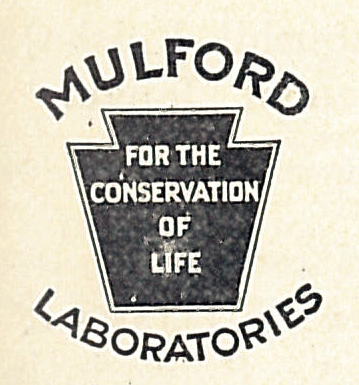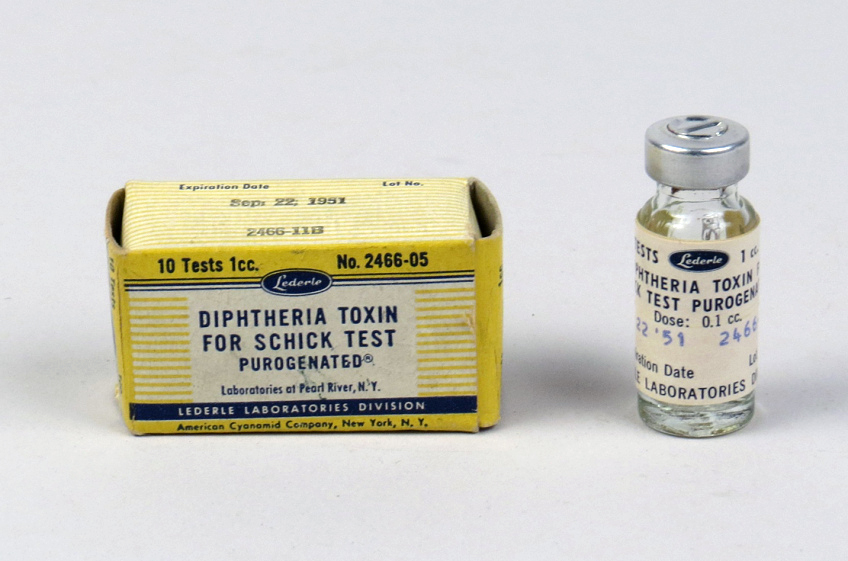Diphtheria Antitoxin, Biologicals, and the Growth of Mulford and Lederle Laboratories
by John S. Emrich
March 2015, pages 20–21
This article originally appeared as an inset article in "Industry Representation in Early AAI."
In 1890, Emil von Berhing announced that he had created a successful diphtheria antitoxin. News quickly made the trans-Atlantic journey and came as a relief to many citizens of U.S. cities, especially New York City. In 1887, one of the largest diphtheria epidemics in the history of the city was responsible for 4,509 deaths. Pharmaceutical companies saw antitoxin as a new opportunity for expansion of their businesses into biologics. H. K. Mulford Company and Lederle Laboratories became large producers of effective diphtheria antitoxins. The two companies, however, achieved their leading market positions by different means.
H. K. Mulford Company
 H. K. Mulford Co. logo, 1922
H. K. Mulford Co. logo, 1922
from The Journal of ImmunologyIncorporated in Philadelphia in 1891, H. K. Mulford Company initially mass-produced some 800 different medical products. Their largest seller was a water-soluble pill made possible by their patented tableting machine. With von Behring’s diphtheria antitoxin discovery, however, the owners recognized the potential for a lucrative new venture in biologics. The change in the business model towards biologics required new hires. In 1894 Joseph McFarland, a noted bacteriologist and pathologist at the University of Pennsylvania, became the first major hire for this new endeavor, and a year later Mulford produced the first commercial diphtheria antitoxin in the country. The antitoxin was an immediate commercial success and the company quickly began expanding the business to other biologicals. This expansion included constructing new laboratories for biological, vaccine, and veterinary research, hiring trained scientists—including physicians, pharmacists, chemists, veterinarians, and botanists—and relocating to a larger property. In 1896 the company moved to a 200-acre farm in Glenolden, Pennsylvania, eight miles outside the city limits, and by 1920 the new site had nearly 1,000 employees and 52 buildings, including stables and barns for the hundreds of horses, cows, and smaller animals. During the 1920s Mulford specialized in human and veterinary serums, antitoxins, and vaccines, and in 1929 they merged with Sharpe & Dohme, Inc. of Baltimore.
Lederle Antitoxin Laboratories
Lederle Antitoxin Laboratories was founded by former health commissioner of New York City Ernest Joseph Lederle in 1906 to produce diphtheria antitoxin. Lederle, a trained chemist, had a strong interest in chemical and bacterial testing as it applied to public health and in 36 years at the New York City Department of Health rose in the ranks from milk inspector (1866) to health commissioner (1902). Three years after von Berhing’s discovery, Lederle was influential in the creation of the NYC Department of Health bacteriology laboratory under the direction of William Hallock Park (AAI 1916, president 1918–1919). The lab focused on methods to identify, control, and prevent communicable diseases. In 1894, Park and Anna Wessel Williams (AAI 1918) isolated the Park-Williams No. 8 strain of diphtheria and used it to create a highly effective antitoxin that was made available to the public the following year. The antitoxin was produced by the Health Department and provided at no cost to physicians in the city and sold at a nominal cost to health departments in other cities. In 1903, however, with the higher standards of commercial antitoxins available and pressure from drug manufacturers to cease their anti-free market production, a Health Department directive forced Park’s lab to cease production and distribution of the antitoxin.
 Diphtheria toxin, Lederle Labs, c. 1951
Diphtheria toxin, Lederle Labs, c. 1951
Smithsonian InstitutionThe following year, 1904, Lederle stepped down as health commissioner after city elections intensified the challenges of the health department’s lab, bringing back into power the longtime political machine. Lederle saw opportunity in customers’ continuing to request the Park antitoxin following the 1903 interruption in production and resolved to answer the demand. Over the next three years, Lederle recruited scientists and past board colleagues, and, in 1906, founded Lederle Antitoxin Laboratories to produce the diphtheria antitoxin. The new company quickly began taking large orders from across the country. The small and “highly skilled” scientific staff made sure the antitoxin maintained the high standards that Park had produced. Large sales volumes required an expansion of the laboratories and a relocation from New York City to a 99-acre farm in Pearl River, New York. In those pre-Depression growth years, Lederle Laboratories touted its highly trained scientists working in their modern laboratories to produce bacteriologically sophisticated products. In the decades that followed, Lederle Laboratories became one of the leading pharmaceutical companies in the United States. Today, after multiple acquisitions, the company is part of Pfizer, Inc.
References
- Condran, Gretchen A. “Changing Patterns of Epidemic Disease in New York City.” In Hives of Sickness: Public Health and Epidemics in New York City. Edited by David Rosner. New Brunswick: Rutgers University Press, 1995.
- Galambos, Louis and Jane Eliot Sewell. Networks of Innovation: Vaccine Development at Merck, Sharp & Dohme, and Mulford, 1895–1995. New York: Cambridge University Press, 1995.
- Liebenau, Jonathan M. “Scientific Ambitions: The Pharmaceutical Industry, 1900-1920.” Pharmacy in History 27, no. 1 (1985): 3–11.
- O’Neil, Robert F. “Recalling the Heyday Of Pioneering Drug Firm The H. K. Mulford Co. Of Glenolden Produced A Breakthrough Diphtheria Antitoxin.” Philadelphia Inquirer. December 27, 1992.
- “In Honor of William Hallock Park.” Science 84, no. 2177 (1936): 261–262.